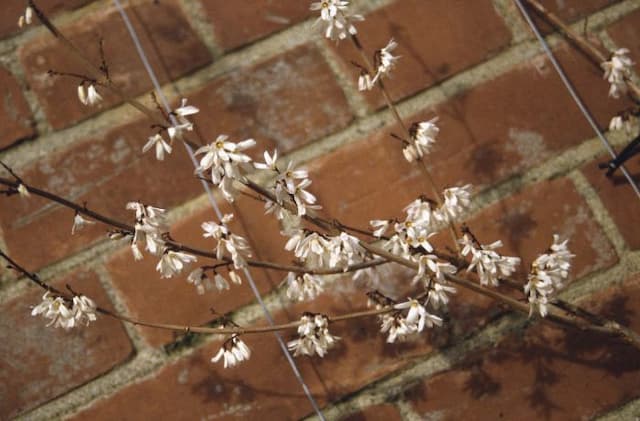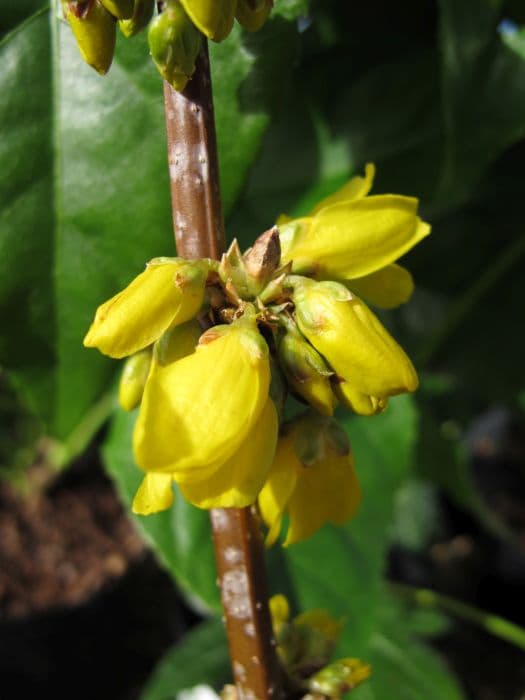Stephan Jasmine Jasminum × stephanense

ABOUT
Jasminum × stephanense, commonly known as the Stephan Jasmine, is a graceful plant with an abundance of twining stems and foliage that create dense coverage. Its leaves are arranged opposite each other on the stem and are pinnately compound, featuring multiple leaflets. The leaflets are ovate in shape and have a glossy, deep green hue which provides a lush backdrop for the plant's blossoms. Flowering mainly during the summer months, the Stephan Jasmine produces delightful clusters of flowers that are especially fragrant during the evening. Each flower in the cluster is delicate and tubular, opening up into five lobes. A characteristic feature of the flower is its color, which is a soft shade of pink. This pastel hue adds a gentle splash of color to gardens and landscapes. The Stephan Jasmine is cherished for its sweet perfume, making it a favorite among gardeners who desire to add a sensory experience to their outdoor spaces. Its twining habit allows it to climb structures, making it ideal for use on trellises, arbors, and fences, where its flowering display can be showcased vertically. As the plant matures, it spreads out, creating an extensive coverage that is both attractive and beneficial for providing privacy or masking less desirable views. In summary, the Stephan Jasmine is a charming plant recognized for its delicate pink blossoms, glossy green pinnate leaves, and enchanting fragrance. It is a versatile climber, blending beautifully into garden designs that aim for aesthetic appeal and aromatic pleasure.
About this plant
 Names
NamesFamily
Oleaceae
Synonyms
Stephan Jasmine, Pink Jasmine
Common names
Jasminum × stephanense
 Toxicity
ToxicityTo humans
The Jasminum × stephanense, known as Stephan Jasmine, is not commonly regarded as a toxic plant to humans. There is limited information specifically detailing its toxicity, but members of the genus Jasminum are generally not considered poisonous. However, as with any plant, individual allergies or sensitivities can exist, and it is always prudent to avoid ingesting plant material that is not known to be safe as food. In case of unexpected reactions or ingestion, medical advice should be sought.
To pets
Stephan Jasmine (Jasminum × stephanense) is also not known to be toxic to pets. Similar to the information available for humans, there is no specific evidence suggesting that this hybrid jasmine is harmful to animals such as dogs and cats. Nevertheless, pets can sometimes have unexpected reactions to plants that humans do not, and consumption of non-food plants can sometimes lead to gastrointestinal upset. Therefore, it's best to prevent pets from ingesting this plant and consult with a veterinarian if any part of the plant is consumed.
 Characteristics
CharacteristicsLife cycle
Perennials
Foliage type
Deciduous
Color of leaves
Green
Flower color
Pink
Height
10-12 feet (3-3.7 meters)
Spread
4-8 feet (1.2-2.4 meters)
Plant type
Shrub
Hardiness zones
6
Native area
China
Benefits
 General Benefits
General Benefits- Aesthetic Appeal: Stephanotis jasmine produces attractive, delicate pink flowers that add beauty to gardens and landscapes.
- Fragrance: The blooms emit a pleasant fragrance, which can enhance the sensory appeal of an outdoor space.
- Pollinator Attraction: The flowers of Stephanotis jasmine can attract pollinators such as bees and butterflies, contributing to the health of the local ecosystem.
- Screening: When grown on trellises or fences, Stephanotis jasmine can provide a natural screen for privacy or to hide unsightly areas.
- Versatility: This plant can be grown in a variety of settings, including as a houseplant, in outdoor containers, or in the ground, making it suitable for different garden styles and sizes.
- Shade Tolerance: Stephanotis jasmine can tolerate partial shade, making it a flexible choice for different sun exposure conditions in the garden.
- Drought Resistance: Once established, it can tolerate periods of dryness, reducing the need for frequent watering.
 Medical Properties
Medical PropertiesThis plant is not used for medical purposes.
 Air-purifying Qualities
Air-purifying QualitiesThis plant is not specifically known for air purifying qualities.
 Other Uses
Other Uses- Jasmine-infused oil: The flowers of Pink Jasmine can be infused in oil to capture the sweet fragrance, which can be used in perfumery or as a scented oil for aromatherapy massages.
- Scented candles and soaps: The extract from Pink Jasmine flowers is often used in the manufacturing of scented candles and soaps, delivering a delicate and appealing scent to these products.
- Floral water: Pink Jasmine flowers can be distilled to create a floral water or hydrosol which can be used as a natural facial toner or a refreshing linen spray.
- Culinary flavoring: While not common, the flowers can be used as an edible decoration or as a flavoring agent for desserts, syrups, and teas, imparting a subtle sweet flavor.
- Textile freshener: Dried jasmine flowers can be placed in sachets and used to freshen up closets, drawers, or other storage areas with the pleasant jasmine fragrance.
- Religious offerings: In some cultures, Pink Jasmine flowers can be used in religious ceremonies or as offerings at places of worship due to their pleasing scent and delicate appearance.
- Art and craft projects: The flowers and foliage can be used in pressed flower art or other craft activities, either as visual elements or for their natural fragrance qualities.
- Jasmine tea preparation: Though typically other species are used for tea, Pink Jasmine can also be added to tea leaves to create a lightly scented jasmine tea.
- Gardening and landscaping: Pink Jasmine is used in gardens for its attractive pink flowers and vining growth habit, suitable for trellises, arbors, or walls.
- Natural dye: The flowers may be used to produce a natural dye for fabrics or yarns, although this use is experimental and not widely documented.
Interesting Facts
 Feng Shui
Feng ShuiThe Pink Jasmine is not used in Feng Shui practice.
 Zodiac Sign Compitability
Zodiac Sign CompitabilityThe Pink Jasmine is not used in astrology practice.
 Plant Symbolism
Plant Symbolism- Love: Jasmine is often associated with love and romance due to its sweet fragrance that is believed to induce emotions of love.
- Sensuality: Its intense scent is also linked to sensuality and intimacy, making it a common element in perfumes.
- Beauty: The delicate white flowers of jasmine symbolize beauty and are often used in beauty products and rituals.
- Purity: White jasmine blooms are commonly associated with purity, making the plant a popular choice in wedding bouquets and ceremonies.
- Femininity: Jasmine's association with delicate beauty and its sweet aroma often connects it to feminine qualities.
 Water
WaterStephanotis should be watered regularly during the growing season, approximately every week, with enough water to saturate the soil without waterlogging, likely around 1-2 gallons depending on the size of the plant and the environmental conditions. During the winter months, reduce watering to every other week, providing enough to keep the soil from completely drying out. It's important to allow the top inch of soil to dry out between waterings to prevent root rot.
 Light
LightStephanotis thrives in bright, indirect light and would do well near a window that receives partial sunlight or filtered light. Direct sunlight, especially during the harsh afternoon hours, should be avoided as it can scorch the leaves. An east or west-facing window covered with a sheer curtain is an ideal spot for this plant.
 Temperature
TemperatureStephanotis prefers temperatures between 60 to 85 degrees Fahrenheit and can survive minimum temperatures of 50 degrees Fahrenheit. Avoid exposing the plant to temperatures below this range, as cold drafts or frost can damage the plant. The ideal temperature range will promote healthy growth and flowering.
 Pruning
PruningPrune Stephanotis after flowering to maintain its shape and encourage more vigorous growth. Trimming back leggy stems and removing any dead or damaged parts promote better air circulation within the plant. The ideal time for pruning is late winter or early spring before the new growth starts.
 Cleaning
CleaningAs needed
 Soil
SoilStephan Jasmine prefers well-drained soil with a pH between 6.0 and 7.5. An ideal soil mix can be made from one-third each of garden soil, peat or compost, and gritty material such as perlite to ensure adequate drainage. Regular top-dressing with organic matter will help maintain soil fertility.
 Repotting
RepottingStephan Jasmine should be repotted every two to three years during the spring. This timing allows the plant to recover from any root disturbance and take advantage of the growing season to reestablish itself.
 Humidity & Misting
Humidity & MistingStephan Jasmine thrives in moderate to high humidity levels, ideally around 40-50%. It is tolerant of typical indoor humidity levels but will benefit from increased humidity, especially during the heating season.
 Suitable locations
Suitable locationsIndoor
Place Stephan Jasmine in bright, indirect light; keep soil moist but not waterlogged.
Outdoor
Plant Stephan Jasmine in partial shade, shelter from cold winds, water regularly.
Hardiness zone
7-10 USDA
 Life cycle
Life cycleThe life cycle of Jasminum × stephanense, commonly known as Stephan's Jasmine, begins with seed germination, which requires a warm, moist, and well-lit environment. Once the seed germinates, the plant enters the vegetative stage, where it develops a network of roots and shoots, providing a foundation for leaves and stems to grow. As the plant matures, it transitions to the flowering stage, typically in late spring or early summer, producing fragrant pale pink flowers that attract pollinators. After pollination, the flowers develop into small black berries, representing the fruiting stage and containing seeds for the next generation. The plant can also propagate vegetatively through cuttings, which take root and grow into new plants. Stephan's Jasmine is a perennial, meaning it will go through cycles of growth, flowering, and dormancy, typically with a period of reduced activity during colder months before resuming growth in spring.
 Propogation
PropogationPropogation time
Spring to Summer
Jasminum × stephanense, commonly known as Stephan Jasmine, is often propagated through semi-hardwood cuttings. This method is done during late summer when the temperature is consistently warm, which provides a favorable condition for rooting. To propagate by cuttings, select a healthy, non-flowering shoot and cut a 4 to 6 inch (approximately 10 to 15 cm) section. Below a leaf node, remove the lower leaves and dip the cut end into a rooting hormone to enhance root development. Plant the cutting in a well-draining soil mix, ensuring at least two nodes are buried. Maintain consistent moisture and high humidity around the cutting, often by tenting with a plastic bag, and keep it in indirect but bright light. After a few weeks, the cutting should develop roots and can eventually be transferred to a larger pot or into the garden.









